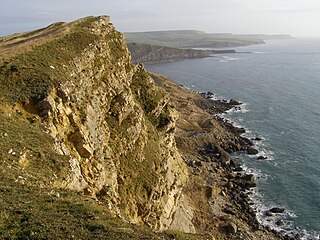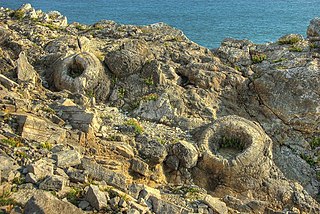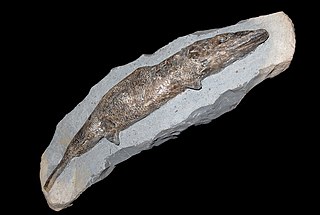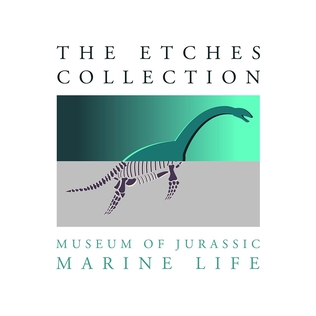
The Jurassic is a geologic period and stratigraphic system that spanned from the end of the Triassic Period 201.4 million years ago (Mya) to the beginning of the Cretaceous Period, approximately 145 Mya. The Jurassic constitutes the middle period of the Mesozoic Era as well as the eighth period of the Phanerozoic Eon and is named after the Jura Mountains, where limestone strata from the period were first identified.

The Jurassic Coast is a World Heritage Site on the English Channel coast of southern England. It stretches from Exmouth in East Devon to Studland Bay in Dorset, a distance of about 96 miles (154 km), and was inscribed on the World Heritage List in mid-December 2001.

The Trachypachidae are a family of beetles that generally resemble small ground beetles, but that are distinguished by the large coxae of their rearmost legs. There are only six known extant species in the family, with four species of Trachypachus found in northern Eurasia and northern North America, and two species of Systolosoma in Chile and Argentina. They were much more diverse in the past, with dozens of described species from the Mesozoic.

Pliosauroidea is an extinct clade of plesiosaurs, known from the earliest Jurassic to early Late Cretaceous. They are best known for the subclade Thalassophonea, which contained crocodile-like short-necked forms with large heads and massive toothed jaws, commonly known as pliosaurs. More primitive non-thalassophonean pliosauroids resembled plesiosaurs in possessing relatively long necks and smaller heads. They originally included only members of the family Pliosauridae, of the order Plesiosauria, but several other genera and families are now also included, the number and details of which vary according to the classification used.

The Indroda Dinosaur and Fossil Park in Gandhinagar, Gujarat, India, is a park that houses fossilized remains and petrified eggs of dinosaurs. It is a man-made fossil park and not the actual nesting grounds where the dinosaurs lived. The eggs and fossils on display here are from the world's 3rd-largest dinosaur fossil excavation site and 2nd-largest hatchery at Raiyoli, Balasinor, Gujarat. The Park was set up by the Geological Survey of India and is the only dinosaur museum in the country.

Derodontidae is a family of beetles, in its own superfamily, Derodontoidea, sometimes known as the tooth-necked fungus beetles. Beetles of this family are small, between 2 and 6 mm in length, typically with spiny margins on their pronotum that give them their name, though the genus Laricobius lacks these spines. Unusual among beetles, they have two ocelli on the top of their heads.

Metriorhynchidae is an extinct family of specialized, aquatic metriorhynchoid crocodyliforms from the Middle Jurassic to the Early Cretaceous period of Europe, North America and South America. The name Metriorhynchidae was coined by the Austrian zoologist Leopold Fitzinger in 1843. The group contains two subfamilies, the Metriorhynchinae and the Geosaurinae. They represent the most marine adapted of all archosaurs.

Kimmerosaurus is an extinct genus of plesiosaur from the family Cryptoclididae. Kimmerosaurus is most closely related to Tatenectes.

Varasichthys is an extinct genus of ray-finned fish that lived during the Oxfordian stage of the Late Jurassic epoch. It contains one species, Varasichthys ariasi, fossils of which have been found in the Domeyko Range of Antofagasta Region, northern Chile. It has been placed in the family Varasichthyidae together with the genera Bobbichthys, Domeykos, Luisichthys and Protoclupea.
Chongichthys is an extinct genus of marine ray-finned fish that lived during the Oxfordian stage of the Late Jurassic epoch. It contains one species, C. dentatus from the Quebrada El Profeta of Chile. It is named after Chilean geologist Guillermo Chong.
Austropleuropholis is an extinct genus of freshwater ray-finned fish that lived during the Late Jurassic. It contains a single species, A. lombardi, from the Kimmeridigian of the Democratic Republic of the Congo, from the terrestrial/freshwater series of the Stanleyville Formation.
Protoclupea is an extinct genus of ray-finned fish that lived from the Oxfordian to the early Tithonian stage of the Late Jurassic epoch. It contains one species, Protoclupea chilensis, fossils of which have been found in the Domeyko Range of Antofagasta Region, northern Chile. The genus has been placed in the family Varasichthyidae together with the genera Bobbichthys, Domeykos, Luisichthys and Varasichthys.

Psiloceras is an extinct genus of ammonite. Psiloceras is among the earliest known Jurassic ammonites, and the appearance of the earliest Psiloceras species form the definition for the base of the Jurassic. Unlike most earlier ammonites, which had complex shell shapes and ornamentation, Psiloceras had a smooth shell.

The Salientia are a total group of amphibians that includes the order Anura, the frogs and toads, and various extinct proto-frogs that are more closely related to the frogs than they are to the Urodela, the salamanders and newts. The oldest fossil "proto-frog" appeared in the early Triassic of Madagascar, but molecular clock dating suggests their origins may extend further back to the Permian, 265 million years ago.

The Fossil Forest is the remains of an ancient submerged forest from Jurassic times, located to the east of Lulworth Cove on the Isle of Purbeck in Dorset, England. It lies on the Jurassic Coast, on a wide ledge in the seaside cliff. The site is within the Lulworth Ranges and thus has restricted access. Parts of forest can also be seen on the Isle of Portland and in quarries near the town of Weymouth to the west.
The Haifanggou Formation, also known as the Jiulongshan Formation, is a fossil-bearing rock deposit located near Daohugou village of Ningcheng County, in Inner Mongolia, northeastern China.

Crossognathiformes is an extinct order of ray-finned fish that lived from the Late Jurassic to the Eocene. Its phylogenetic placement is disputed; some authors have recovered it as part of the teleost stem group, while others place it in a basal position within crown group Teleostei. Other placements have found it to be polyphyletic, with Varasichthyidae being stem-group teleosts whereas the other, "true" crossognathiforms are crown-group teleosts within Teleocephala.

Lytoceras is an ammonite genus that was extant during most of the Jurassic and Cretaceous periods, and is the type genus for the family Lytoceratidae. These cephalopods were fast-moving nektonic carnivores.

The Etches Collection is an independent fossil museum located in the village of Kimmeridge, Dorset, England. It is based on the lifetime collection of Steve Etches, a fossil hunter for whom some of his finds have been named, from the local area on the Jurassic Coast, a SSSI and World Heritage Site, especially around Kimmeridge Bay and the Kimmeridge Ledges.

Aratasaurus is an extinct genus of basal coelurosaurian theropod dinosaur from the Early Cretaceous (Aptian) Romualdo Formation of Brazil. The genus contains a single species, A. museunacionali, known from a partial right leg. Aratasaurus represents the only tetrapod fossil known from the lower levels of the Romualdo Formation.
















